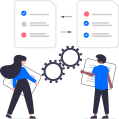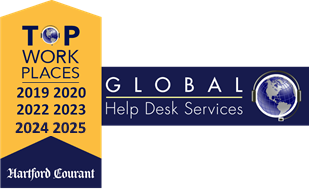Top 10 Help Desk
Challenges—and How
to Overcome Them
Be the best by learning
from the rest
Does Your Help Desk Need Help?
Your IT help desk exists for one reason—to help callers solve their IT challenges. But when your help desk faces challenges, who do they call for help?
Maybe your help desk is faced with challenges enforcing service levels, providing adequate coverage, managing staff turnover or scaling to meet demand.
At Global Help Desk Services, Inc. (GHDSi), we’ve been helping help desks address their top challenges for more than 20 years. Along the way, we’ve learned what works, and what doesn’t. Read our guide to discover what your help desk can do to overcome the top 10 help desk challenges.
Top 10 Most Common
Help Desk Challenges

1. Service Levels
You don’t have documented service levels. Or, if you do, you don’t enforce them.

2. Coverage
You’d like to expand coverage hours but can’t justify the cost of increasing your headcount.

3. Customer Satisfaction
You receive too many complaints about availability and resolution.

4. Best Practices &
Expert Tools
You don’t have critical tools, processes and practices in place to “inspect what you expect.”

5. Staff Turnover
You spend too much time and money hiring and training staff at your help desk.

6. Multi-Roles
Your help desk staff perform other duties, compromising their productivity.

7. Skillset
Your help desk staff are generalists. Specialized skills are non-existent.

8. Scalability
You have trouble scaling up and scaling down to meet fluctuations in demand.

9. New Business
Your company is expanding quickly, and your help desk can’t keep up.

10. New Rollouts
New technology and application rollouts strain your scarce help desk resources.
Read on to find solutions to the top challenges facing help desks today.
Want to know where you stand with these top 10 help desk challenges? Complete the self-assessment checklist to see where your help desk might need some help.

Help Desk Challenge 1
Service Levels:
Expectations and Accountability
Help desk service levels are all about expectations and accountability. You announce your expectations, and you hold people accountable if they fail to meet those expectations.
But the trouble with service levels is that many help desks don’t have any. Or at least they don’t have any service levels that are documented and published. Or, if they do have published service levels, they don’t enforce them, which amounts to the same thing.
When your help desk has no service level expectations or no accountability (or both), your help desk suffers, and your users suffer.

Your help desk suffers
Inconsistent service levels gradually erode the reputation you’ve worked so hard to build.
Additionally, with no expectations or accountability, staff have no way to know if they’re doing a good job – and no way to improve their performance. When expectations and accountability are clearly communicated and fairly applied, employees can grow into their role.

Your users suffers
Inconsistent service levels hurt your users. They never know what to expect when they contact your help desk. They lose confidence in IT overall because your help desk is the face of IT. And, often, they stop contacting your help desk altogether.
In short, inconsistent service levels mean some users get their issues resolved and others don’t, but you never know why.
The solution is to develop and enforce service levels. Also, establish predictable, repeatable processes that bring stability to your help desk. These processes let your help desk staff know what is expected of them when they come to work every day, what your users can expect when they contact thoutsoure help desk, and what IT teams can expect when you escalate a ticket to them. Offer meaningful incentives, helpful guidance, and fair penalties that encourage achievement. You’ll quickly notice a distinct improvement in your customer satisfaction levels.

Help Desk Challenge 2
Coverage:
Planning for Peaks and Valleys
If your help desk is typical, you are busier at certain times of the day, or night, than you are at other times. Sometimes these peaks and valleys are predictable, but not always.
As you expand coverage into other time zones, your challenges increase. Providing excellent help desk services becomes more complex. You face challenges with:
 Maintaining adequate staffing levels
Maintaining adequate staffing levels Making allowances for time
Making allowances for time Accommodating last-minute shift coverage
Accommodating last-minute shift coverage Managing daily help desk staff
Managing daily help desk staff Establishing effective hand-offs
Establishing effective hand-offs

Peaks and valleys in coverage give you the added challenge of justifying the cost of extra personnel to cover off-hours. During these periods, reduced call volumes either leave your staff at 2am with nothing to do, or they encourage you to assign unrelated tasks to help desk staff just to keep them busy, which makes it harder to evaluate their overall performance (and it’s not great for morale, either).
One solution to your peaks and valleys challenge is to outsource all or part of your coverage to a help desk partner. This expands your coverage, improves customer service, improves your first call resolution rate and more—without increasing your headcount.

Help Desk Challenge 3
Customer Satisfaction: Reputation of IT
Is your help desk receiving too many customer complaints about availability and resolution? Then you have a challenge with customer satisfaction. And poor customer satisfaction can quickly snowball into an untenable situation, as users either call repeatedly to get issues fixed… or worse, they stop calling altogether and start looking elsewhere for help.
Poor customer satisfaction is a canary in the coal mine when it comes to the reputation of IT and a company’s productivity and employee engagement. In other words, the group that has the greatest impact on customer satisfaction, and IT’s reputation, is the help desk.
Consider this common scenario: An employee loses several hours out of several days while dealing with a singularly unhelpful help desk. Now that employee is behind in her work, her manager isn’t happy, and everybody is frustrated. If this happens often with your help desk, you’ll have poor customer satisfaction ratings – and eventually, a lot of questions from leadership.
Three Ways to Boost
Help Desk Customer Satisfaction:

Answer Promptly
Ensure your callers don’t spend excessive amounts of time in a queue (avoid long answer times).

Keep Them Talking
Keep your callers engaged so that they don’t get frustrated and hang up (causing high abandon rate).

Empower Your Agents
Hire knowledgeable, helpful agents and empower them to solve issues without escalation (which boosts your first call resolution rates).

Help Desk Challenge 4
Best Practices: Standards,
Processes, Tools, and Habits
Most help desks are always striving to improve. And one of the best ways to raise the bar is by figuring out where you want to be, and then figuring out how to get there.
Yes, we’re talking about establishing standards, implementing clear processes, and then providing the tools that help new habits form.
The problem is, where do you start?
Here are some best practices and tools you can start implementing immediately to raise your standards and develop good habits.

QA
Perform agent QA reviews regularly.

CSAT
Conduct customer satisfaction surveys on a regular basis.

Knowledgebase
Implement a web-based knowledgebase tool.

Automation
Implement service request automation processes in your help desk software.

Communication
Use your help desk software to increase communications with agents and customers.

Reporting
Use real-time reporting to visualize your help desk effectiveness

Help Desk Challenge 5
Staff Turnover:
Retaining Talent
Does your help desk spend too much time and money hiring and training staff? Then you have an employee turnover problem, or an employee retention problem, depending on how you look at it.
And that problem is costing you plenty. Last time we checked, the cost to replace a help desk agent was $12,000. Replacing agents is costly because it involves recruiting, screening, interviewing, onboarding, and training a new agent.
But turnover also costs you in other ways, by reducing productivity as the new agent learns on the job, by increasing your overtime expenses as you backfill vacant positions, and in loss of company knowledge, which hinders operations and performance.
How to Improve Your Agent Retention Rate:

Hire for EQ, Not IQ
Hire candidates who are empathetic and good listeners, and who genuinely like talking to people.

Recognize Your Agents
Acknowledge agents and empower them: 50% of employees will stay if they are tangibly recognized.

Monitor Absenteeism
Before agents quit, they quit coming in. Find the reasons behind high absenteeism and address them.

Outsource
Outsourcing increases your operational efficiency and eliminates agent turnover headaches at the same time.

Help Desk Challenge 6
Multi-Roles:
Balancing Workloads
How much of the day do your help desk agents devote to taking inbound calls? 100%? 80%? 50%?
If you operate a small IT shop, your help desk staff likely have multiple IT roles besides just fielding support requests. And the challenge you face when agents have multiple roles is that non help desk roles sometimes take priority. This can cause a number of problems.
Too Many Hats
When your help desk agents spend too much time doing other tasks, expect some problems.
 Wait Times Increase: Call wait times increase and there is a greater volume of abandoned calls.
Wait Times Increase: Call wait times increase and there is a greater volume of abandoned calls. Customer Satisfaction Drops: User satisfaction and employee productivity decrease until users stop calling altogether.
Customer Satisfaction Drops: User satisfaction and employee productivity decrease until users stop calling altogether. Productivity Declines: As employees become disenchanted, they turn to other users for assistance, decreasing productivity for both parties.
Productivity Declines: As employees become disenchanted, they turn to other users for assistance, decreasing productivity for both parties. Underground Support Climbs: When IT staff make a desktop visit, they get flagged down and end up providing “underground” support to these dissatisfied users.
Underground Support Climbs: When IT staff make a desktop visit, they get flagged down and end up providing “underground” support to these dissatisfied users. Perception Fails: Help desk processes are not reinforced and gaining an accurate assessment of true workload is rarely possible.
Perception Fails: Help desk processes are not reinforced and gaining an accurate assessment of true workload is rarely possible.
Solving this issue first requires an accurate assessment of your help desk needs. From there, you will need to make some strategic decisions around your staffing levels. Many companies solve this issue by outsourcing their first-level help desk support, only sending escalated calls to in-house IT staff. This frees up IT staff to handle other important tasks while still using their expertise for complex issues.

Help Desk Challenge 7
Skillsets:
Hiring for the Right Skills
When hiring for your IT help desk, how do you find the people who have the right mix of hard skills and soft skills, technical know-how and people skills?
And how do you ensure that the people you recruit, onboard, train and equip will stay with you?
One of the challenges facing IT help desks today is hiring individuals who have the right mix. After all, some candidates are strong on technical knowledge and expertise, but are frankly terrible at customer service. Other candidates have the people skills you are looking for but lack technical expertise or help desk experience.
We recommend you look for candidates who possess the qualities shared by top help desk agents.

Emotional Intelligence
High level of self-awareness, empathy, and internal motivation—all required to be successful in a people-facing, demanding environment.

Communication Skills
Good customer service skills to interact continuously with clients and be ready to assist them with whatever they require.

Technical Knowledge
Easily answer task-based questions related to your frequently asked questions, and articulate steps they take to solve problems.

Initiative
Previous roles and examples they give during the interview show that they take charge of a situation to help others and don’t shirk responsibility.

Help Desk Challenge 8
Scalability:
Managing Change
Do you face challenges scaling up and scaling down to meet fluctuations in demand? This is a common challenge with help desks. Headcount is rarely easy. After all, if you scale up by hiring new staff when you are busy, you end up having a surplus of staff when things go quiet again. And if you scale down when things slow down, you run into trouble with meeting coverage and service level agreements when call volumes increase again.
The challenge of scalability also comes down to the cost and time investment needed to bring on a new hire, which includes:
 Posting a position
Posting a position Reviewing resumes
Reviewing resumes Creating a list of candidates to interview
Creating a list of candidates to interview Interviewing candidates
Interviewing candidates Creating a shortlist
Creating a shortlist Interviewing the candidates on the shortlist
Interviewing the candidates on the shortlist Checking references and conducting background checks
Checking references and conducting background checks Negotiating salary and benefits
Negotiating salary and benefits Hiring the best candidate
Hiring the best candidate Purchasing computers, software, telephones
Purchasing computers, software, telephones Setting up hardware and software
Setting up hardware and software Approving security credentials
Approving security credentials Configuring access
Configuring access Onboarding
Onboarding Training
TrainingNaturally, most help desks can’t afford to go through this process every time work picks up, only to be forced to lay off agents when things slow down again. By using a simple Erlang staff scheduling tool you can get a better handle on your staff needs based on call volume arrival patterns. You can also look at part-time employees to help with those days/times when you have peaks.
Outsourcing is a viable alternative to spending all the time and money you need to hire IT help desk professionals.
Outsourced help desk providers deliver professional help desk outsourcing services to enterprises, becoming the initial point of contact to help your customers and employees resolve technical issues. This enables your company to dedicate attention to core services and competencies, while providing your staff and customers with a satisfying IT help desk experience.

Help Desk Challenge 9
New Business:
Navigating Business Growth
Talk to business executives, and they’ll tell you that increases in revenue, profit, and market share are good things. They’ll tell you that growth through acquisitions, growth into new countries and growth through new business offerings are all desirable.
But talk to the managers and agents in the IT help desks at those same companies, and you’ll discover that rapid growth puts immense pressure on help desks. If your company is expanding quickly, your help desk may struggle to keep up with call volumes or the nature of support issues.
Acquisitions present unique challenges. How will your current team arrange procedures and train the new team before the new business is brought on in time? Do you even have the capacity to support the new business? If not, you have the challenge of hiring and training new staff.
When growth outpaces service capacity, your call volumes go up, and your service levels (and customer satisfaction ratings) go down.
This problem can be addressed in much the same way as how you would handle other peaks or fluctuations. Assigning your core IT staff to the task of high-level calls and process implementation while delegating first-level calls to an outsourcing partner is a smart way to handle rapid growth without sacrificing service levels.

Help Desk Challenge 10
New Rollouts:
Effective Training and Staffing
In a typical enterprise, a user calls the help desk 1.25 times per month. Do the math, and you see that a help desk within an enterprise that has 1,000 users will field 1,250 calls per month. That’s 58 calls a day, 288 calls a week, 15,000 calls a year.
When a business environment has a stable IT infrastructure, systems and software, and is properly staffed, the average user will call the help desk only 0.66 times a month. In an unstable environment — one that experiences unusual downtime or has had recent upgrades, or a new rollout — this number can easily be over 3 times per month.
Cranking Up the Volume
The number of calls your help desk fields each day depends on whether your staffing levels,
tools and processes are above average, average, or below average.
| Call Volume | ||||
|---|---|---|---|---|
| Daily | Weekly | Monthly | Yearly | |
| Poorly Managed Help Desk | 30 | 152 | 660 | 7,920 |
| Average Help Desk | 58 | 288 | 1,250 | 15,000 |
| Well-Managed Help Desk | 138 | 692 | 3,000 | 36,000 |
Managing these call volumes comes down to planning your staffing and training. If your help desk doesn’t have the capacity to handle an increase in call volume, calls will get backed up and everyone will be unhappy. Training makes a huge difference, because well-trained staff can handle an increase in calls effectively and in a timely manner. Rollouts affect customer satisfaction, service levels, and IT’s organizational reputation.
Where Do You Stand on these Top 10 Help Desk Challenges?
Complete this checklist to see where your help desk might need some help.
Complete this checklist to see where your help desk might need some help. (1) for Satisfied, (2) for Neutral, (3) for Dissatisfied and (4) for Don’t Know.
| Challenge | Satisfied 1 | Neutral 2 | Dissatisfied 3 | Don’t Know 4 |
|---|---|---|---|---|
| Service Levels |
|
|
|
|
| Coverage |
|
|
|
|
| Customer Satisfaction |
|
|
|
|
| Best Practices |
|
|
|
|
| Staff Retention |
|
|
|
|
| Workload Balance |
|
|
|
|
| Skillsets |
|
|
|
|
| Scalability |
|
|
|
|
| New Business |
|
|
|
|
| New Rollouts |
|
|
|
|
Operating an efficient help desk is a balancing act. You must:
- Deliver adequate service levels
- Supply adequate coverage
- Maintain positive customer satisfaction scores
- Use best practices and tools
- Retain agents
- Balance workloads
- Ensure your agents have the right skillsets
- Scale up and down as needed
- Manage the stresses that come with growth, and...
- Manage new rollouts
And you need to do all of this with an eye on your budget and staff morale. It’s a tall order, which is why enterprise companies — from Fortune 100 financial services organizations to pediatric hospitals to marine transportation firms — trust GHDSi for help desk outsourcing.
About Global Help Desk
Services, Inc.
Global Help Desk Services, Inc. (GHDSi) provides help desk outsourcing with guaranteed service levels to enterprise-sized companies around the world. Help desk outsourcing is 100% of our focus. It’s all that we do.
GHDSi is the first point of contact for your employees and customers when they need tech support. We manage their technical issues, resolve their problems, and escalate issues that you prefer to resolve in-house.
When you outsource your help desk to GHDSi, you gain the freedom to focus on your core competencies. You innovate. You drive business growth. And you improve customer service. Learn more about Help Desk Outsourcing. Or schedule a free consultation.
It’s Your Call
Ready to outsource your help desk to the experts?
Let’s discuss your help desk goals and challenges.










